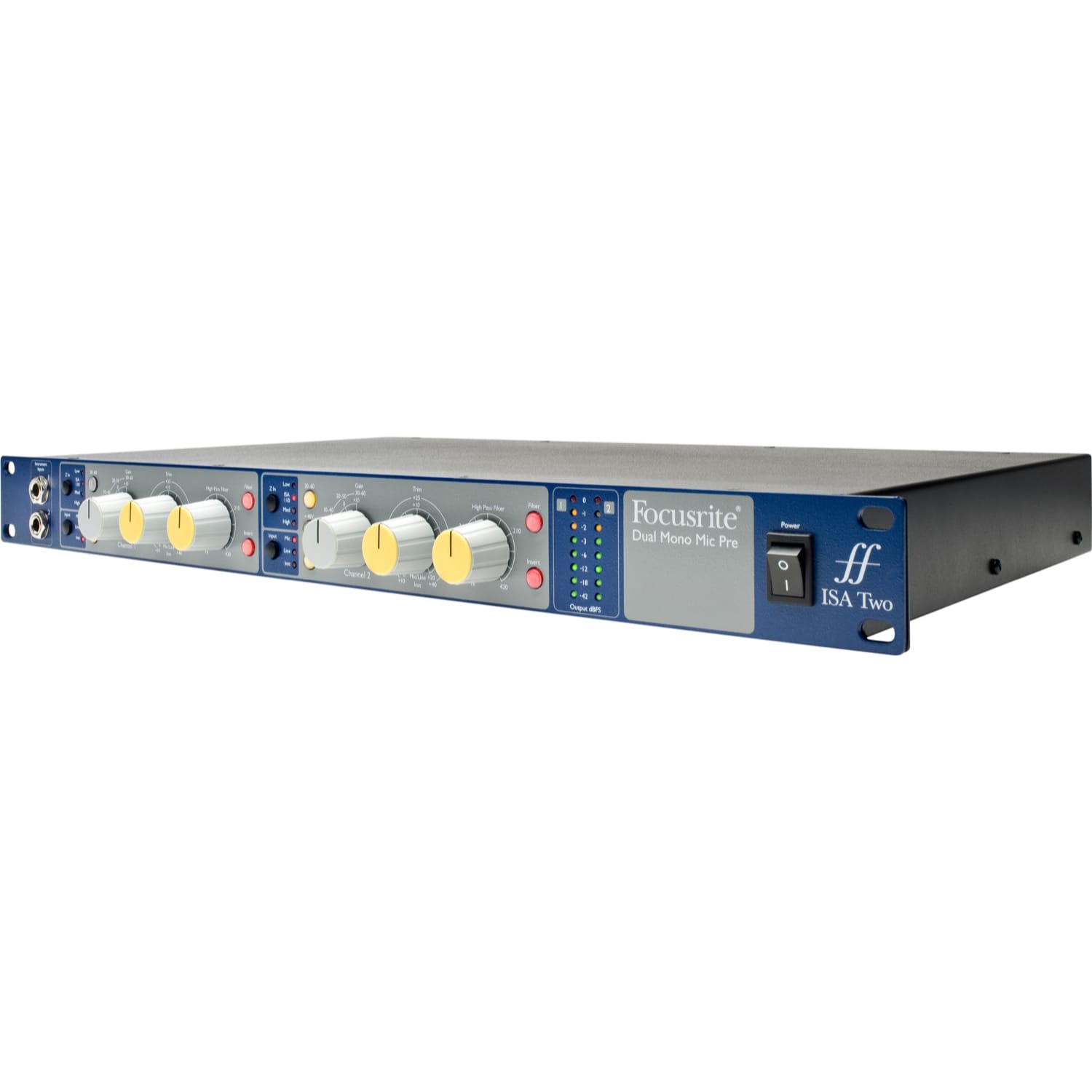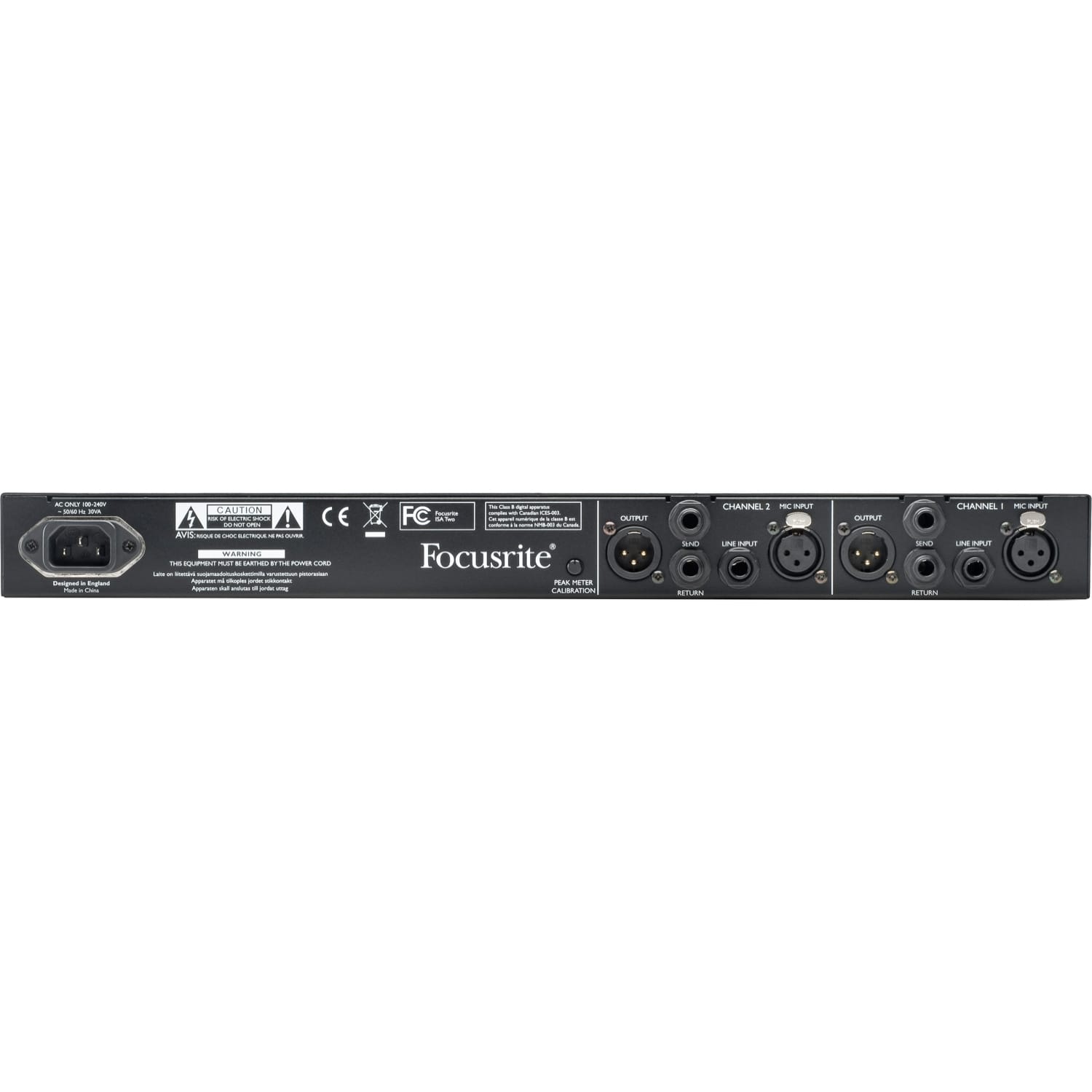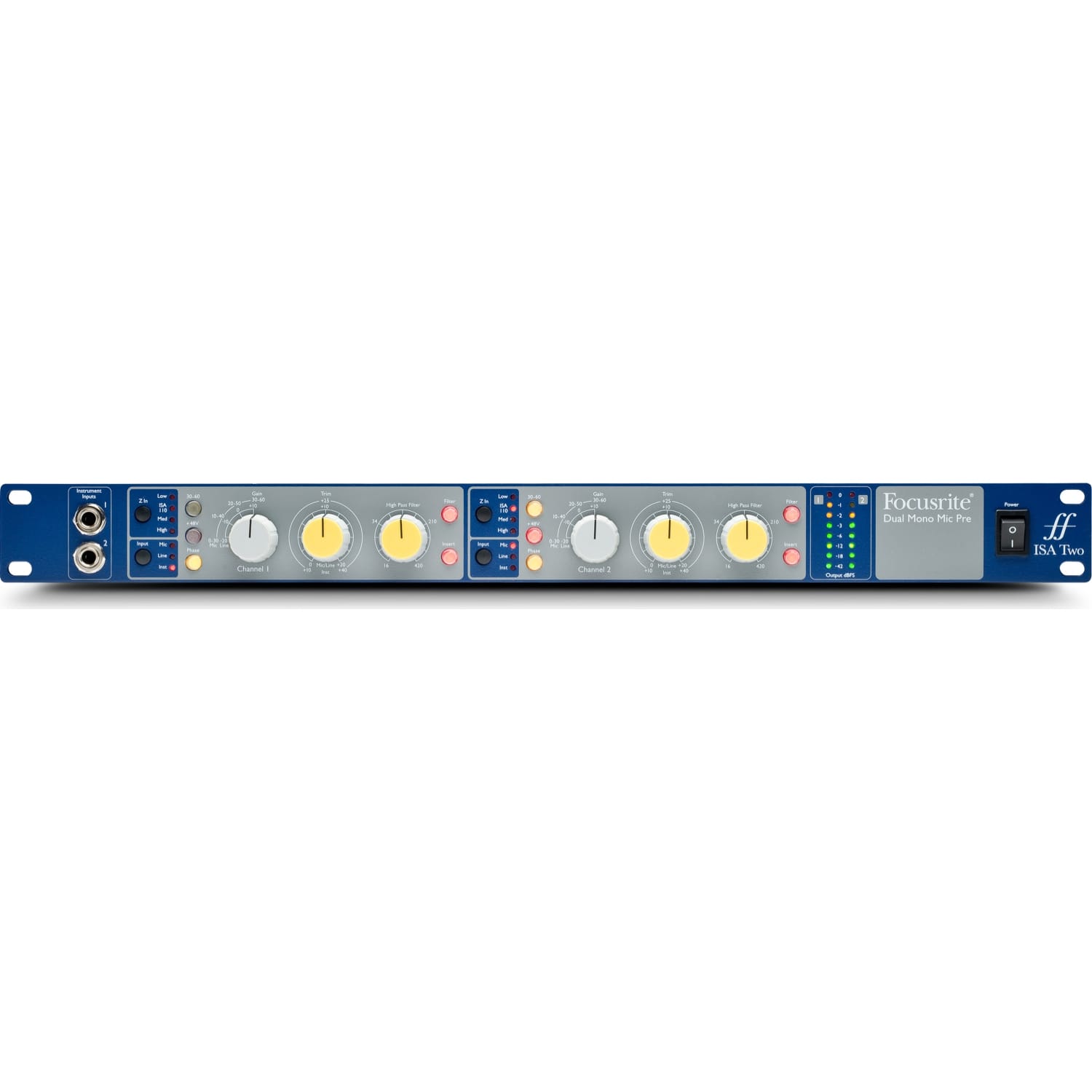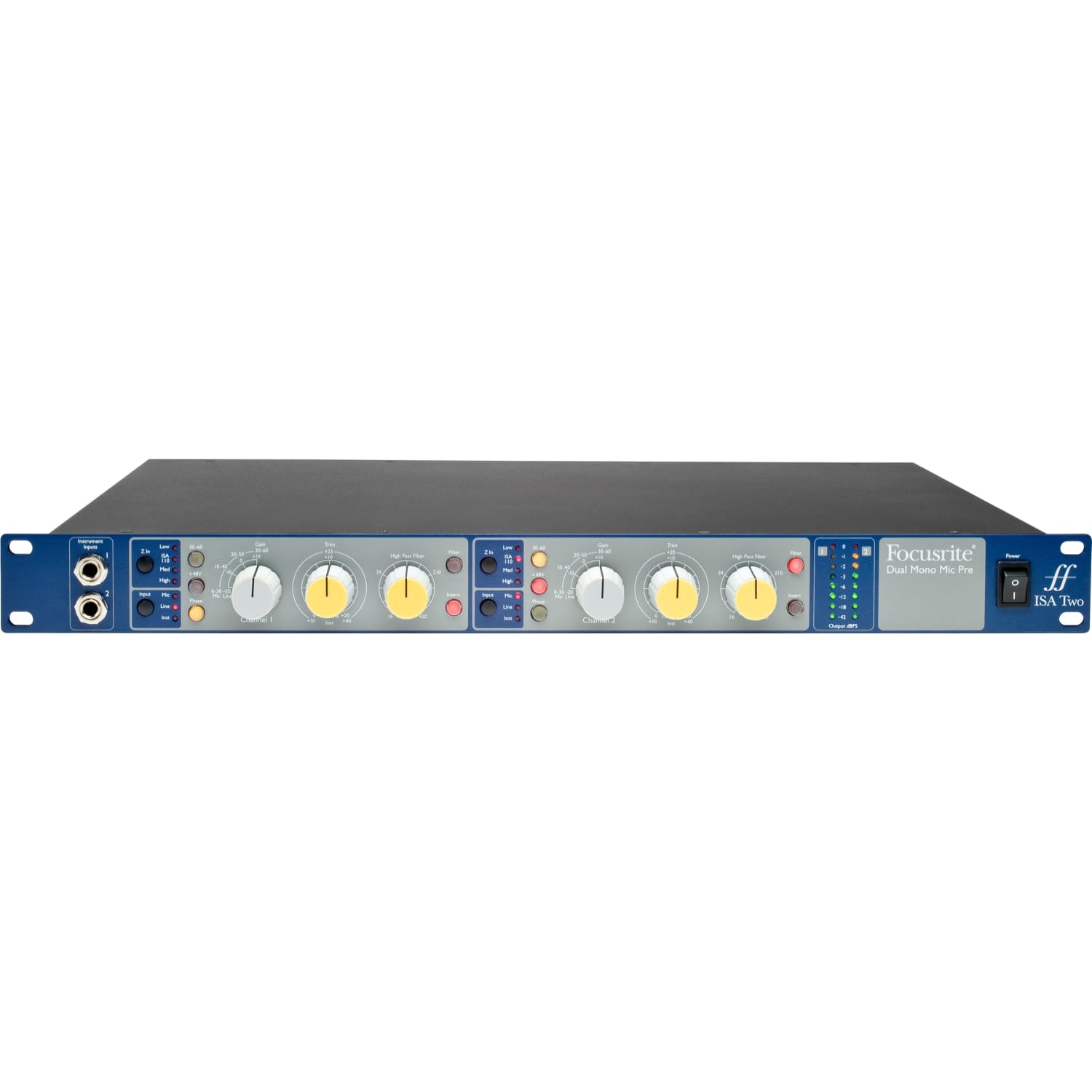Key Features
- Dual Mono
- Transformer Based Microphone Inputs
- Variable Input Impedance
- Front Panel Instrument Inputs
- Rear Panel Line Inputs
- Per Channel Insert Points
- Per Channel High-Pass Filters
- Phantom Power
- Phase Reverse Switches
- User-Calibrated Metering
Description
2-Channel Mic/Instrument Preamp with 80dB of Gain, Switchable Phantom Power, Variable Hi-Pass Filters, and Variable Input Impedance
You may only need a couple of mic preamps, but they need to be the very best. The ISA Two dual-mono mic pre is the ideal solution: two independent channels of the highest quality classic Focusrite mic pres, with line in and front-panel instrument inputs - no DI box required. Based on the legendary designs found in the Focusrite Forte and Studio Consoles, ISA Two is the ideal front-end for your rack.
Superb sound spanning four different decades
Focusrite's microphone preamplifiers go back to the original Focusrite ISA 110 modules, when Rupert Neve was commissioned by George Martin in 1985 to create a no-compromise channel strip for his Neve console. Combining the very best solid-state electronics with transformer coupling, Focusrite mic pres have played a key part in the recording of hundreds of hit records and they're the choice of leading artists, producers and engineers around the world.
Lundahl Transformers
At the heart of the ISA Two is a pair of Lundahl LL1538 transformers. ISA products have relied on Lundahl from the beginning, since their components were originally specified in 1985. The LL1538 features a 3-section winding, resulting in very low leakage inductance and, as a result, an extended frequency response. They're encapsulated in mu-metal cans to shield them from stray magnetism.
Variable input impedance and up to 80 dB of gain
ISA Two features two classic Focusrite mic preamps, with four impedance settings including the original ISA 110 setting. Variable input impedance allows you to go for an accurate, transparent sound or choose to highlight the character of your favourite vintage mic - and anywhere in between. With up to 80 dB of low-noise gain, ISA Two can perform in the most demanding situations - really bringing your ribbon, condenser or moving coil mics to life.
Insert your choice of processors
Each channel has a fully-balanced insert point accessed via TRS sockets on the rear panel and activated with a front-panel button, so it's easy to use outboard processors with the ISA Two. Just plug in your choice of EQ, compressor or limiter.
Features:
-
Lundahl LL1538 mic input transformer
Rupert Neve originally chose the Lundahl LL1538 to be the input transformer on the ISA 110. To this day the Lundahl transformer remains the best microphone input transformer available, and is used in every ISA Series mic pre. Rupert Neve also perfected the Zobel network found in the ISA circuit; something which takes a lot of knowledge and a golden set of ears. This allows the ISA mic pre to maintain an extremely flat frequency response across a very wide bandwidth. -
Up to 80 dB of gain
ISA Two offers up to 80 dB of clean, distortion-free gain. The much-heralded ISA topology also ensures low-noise even at the highest gain levels. The transformer alone supplies 20 dB of gain, while ISA's input stage offers up to 60 dB in addition, giving an astonishing 80 dB of maximum gain on the microphone input. -
Variable input impedance
Four choices of input impedance, including the original ISA 110 value, allow you to match the preamp to your microphone, even if it's a vintage type, giving you the best possible sound. The impedance is selected using a switch on the front panel, and the impedance choice is remembered even once the unit is switched off and back on. -
User-calibrated metering
Each channel has an eight-LED array to clearly display the level of your two signals. You can line up your analogue evels with your converters or DAW by using the calibration knob on the rear panel. You will be safe in the knowledge that you have avoided clipping on the way in. -
Front-panel instrument and rear panel line inputs
Two 1/4in jack sockets on the front panel of ISA Two give you instant access to a transparent DI input. TRS line inputs are available on the rear panel too, and you can step through them instantly to select the one you want. -
Variable cut-off high-pass filter
Built in, and easily accessed with its own large knob and illuminated button, is an extremely smooth-sounding 18 dB/octave high-pass filter of the same design as the original ISA 110 module. This is ideal for cutting out rumble, thumps and other unwanted low-frequency sounds and with a range of 16 to 420 Hz, it's easy to lose what you don't want, and keep what you do. -
Rear panel balanced inserts
Each channel of ISA Two has its own balanced insert point. With 1/4" TRS send and receive connections, your choice of signal processor can be connected and switched in and out using the illuminated switch on the front panel.
Specifications:
- Front panel, per channel:
- 1/4" instrument input
- Variable input impedance - Low, ISA 110, Medium, High
- Input selection - Mic, Line, Instrument
- 0 - 30 dB/30 - 60 dB gain switch
- Phantom power switch
- Phase invert switch
- 0 - 60 dB gain in 10 dB steps
- 0 - +20 dB continuously variable trim
- Variable high-pass filter with on/off switch
- Insert point on/off switch
- Eight-LED user-calibrated level meters
- Single power switch
- Rear panel, per channel:
- XLR-F mic inputs
- 1/4" TRS line inputs
- 1/4" TRS Sends
- 1/4" TRS Returns
- XLR-M line output
- Single peak meter calibration dial
- Single IEC power socket
- Measured Performance
- Maximum Input and Output Levels
- Maximum Output Level
+24 dBu with a THD+N < 0.01% at 1kHz measured with 150 Ω source impedance and 22Hz/22kHz band-pass filter - Maximum Microphone Transformer Input Level
+7 dBu with a THD+N < 0.7% at 1kHz measured at 0 dB of gain with 150 Ω source impedance and 22Hz/22kHz band-pass filter - Mic Input Response
- Gain range
0 dB to +60 dB in 10 dB steps, plus 0 dB to +20 dB continuously variable trim - Input Impedance
Switched Impedance setting
Equivalent Input Impedance at 1 kHz
Low = 600 Ω
ISA 110 = 1.4 kΩ
Med = 2.4 kΩ
High = 6.8 kΩ - EIN (Equivalent Input Noise)
Measured at 60 dB of gain with 150 Ω source impedance and 22 Hz-22 kHz band pass filter
-127 dB - Noise
Noise at output with unity gain (0 dB) and 22 Hz-22 kHz band pass filter
-97 dBu - Signal-to-Noise Ratio
Measured with 150 Ω source impedance and 22 Hz-22 kHz band pass filter
121 dB relative to max output +24 dBu - Total Harmonic Distortion + Noise
Measured with a -20 dBu input signal at +30 dB of gain and with a 22 Hz-22 kHz band pass filter
< 0.0007% at 1 kHz - Frequency Response
- At minimum gain (0 dB)
-0.5 dB at 10 Hz,
-1 dB at 135 kHz, relative to 1 kHz - At +60 dB gain
-6 dB at 10 Hz,
-1 dB at 115 kHz, relative to 1 kHz - CMRR (Common Mode Rejection Ratio)
-94 dB for mic input at 60 Hz for max. output = +24 dBu
-91 dB for mic input at 10 kHz for max. output = +24 dBu - Crosstalk Channel to Channel: Mic input, with I/P = 0 dBu, gain = 0 dB @ 1 kHz input to channel A, channel B output = -85 dB
- Line Input Response
- Gain Range: -20 dB to +10 dB in 10 dB steps, plus 0 dB to +20 dB continuously variable trim
- Input Impedance: 10 kΩ from 10 Hz to 200 kHz
- Noise
- Noise at main output with gain at unity (0 dB) measured with 50 Ω source impedance and a 22Hz - 22 kHz band pass filter
-97 dBu - Signal-to-Noise Ratio
- Measured with 50 Ω source impedance and a 22 Hz-22 kHz band pass filter
121 dB relative to max output +24 dBu - Total Harmonic Distortion + Noise
- Measured with a 0 dBu input signal, +10 dB of gain and a 22 Hz-22 kHz band pass filter
< 0.002% at 1 kHz - Frequency Response:
- At unity gain (0 dB)
-0.3 dB at 10 Hz,
-1 dB at 80 kHz, relative to 1 kHz - Crosstalk Channel to Channel:
Line input, with I/P = 0 dBu, gain = 0dB @ 1 kHz input to channel A
Channel B output = -91 dB - Instrument Input Response
- Gain Range: +10 dB to +40 dB continuously variable trim
- Input Impedance: > 2 MΩ
- Noise: >Measured with 22 Hz-22 kHz band pass filter
Minimum gain (+10 dB) = -95 dBu - Frequency Response:
- At minimum gain (+10 dB):
-0.1 dB at 10 Hz,
-1 dB at 115 kHz, relative to 1 kHz - At maximum gain (+40 dB):
-2.5 dB at 10 Hz,
-1 dB at 110 kHz, relative to 1 kHz - High-Pass Filter
- Roll-Off: 18 dB per octave (3 pole filter)
- Frequency Range: Continuously variable from 16 Hz to 420 Hz (-3 dB)
- Weight and Dimensions
- W x D x H: 480 mm x 280 mm x 44 mm
- Weight: 3.7 kg
- Manufacturer: Focusrite
- MPN: ISA TWO
- Model Number: ISA Two
- UPC: 815301005148




